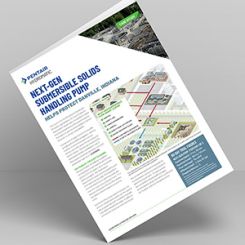This article is the last in a series of six parts. Read the other parts of the series here. The previous articles in this series (Pumps & Systems, November 2015, December 2015, January 2016, March 2016 and May 2016; read them here) discussed some of the main challenges that modern wastewater composition places on sewer systems. The articles presented ways to minimize the associated risk. As mentioned in this series, the production of so-called “non-woven products” has grown tremendously in recent years, and the problem is likely to remain. Not all of these non-woven products end up in the world’s wastewater transport systems. The most dangerous items are “disposable” wipes. Because these products’ labels imply that they are harmless to sewer systems, most users dispose of them by flushing them down the toilet. This habit is particularly problematic for nurseries, retirement homes and other similar facilities where dischargers are connected to the municipality sewerage. In certain ranges and fields, measures are in place to minimize the risk of improper disposal into the sewerage. Unfortunately, many of these measures are not yet fully effective. Various fields are working on improvements to this worldwide infrastructure challenge.
 Image 1. A bar screen is loaded with “flushable” products. (Images and graphics courtesy of KSB Inc.)
Image 1. A bar screen is loaded with “flushable” products. (Images and graphics courtesy of KSB Inc.)Non-Woven Products
The update certificate that categorizes certain products as “flushable” is based on a test that is not optimized for the whole way through the sewer, even if the toilet does flush the product. Better and more realistic tests are being developed to identify wipes that are truly flushable and that will not create difficulties for the sewer and the system. The intended goal has to be very similar to toilet paper. The research and development is focused on developing products that are resistant and durable, yet easily disintegrate after use.Municipalities
Many municipalities and operation companies have campaigns in place to educate the discharger and residents about the consequences and long-term costs of disposable wipe use on sewer systems. The cost increase has to be balanced by higher payment from all residents and the discharger. In some cases, operating companies work hard to remove clogged wipes, dry them and identify the brand in order to hire a lawyer and give the invoice to the wipe manufacturer—especially if the product is labeled “flushable” and evidence shows that it is not. This process is costly and could be avoided if people understood the dangers of these products. In some cases, the increase in the disposal of wipes and similar loads in limited areas was so extreme that finding the cause required visiting homes. In severe cases, penalties resulted.Engineering
Many skilled engineers understand the risk of clogging and are designing advanced pumping stations and pump sumps to better deal with the new composition of sewerage. In the case of variable frequency drive (VFD) operation, the minimum velocity is considered more carefully to enable the wipes to be flushed out of the pipes. Figure 1. This graph shows the sequences for de-ragging speed over time.
Figure 1. This graph shows the sequences for de-ragging speed over time.Pump Industry
The pump industry has come out with new developments in hydraulics that are designed to meet these challenges. However, hydraulics still cannot guarantee an absolute clog-free operation for the system because of extreme conditions in the system or pump station, even if sometimes they are temporary. The screens and pipe systems, including valves and the sump, can be affected. Potential solutions can come from new technologies. For example, one type of impeller can handle all kinds of raw sewage and transport everything through without chopping and a hackle. This impeller’s asymmetrical blade arrangement offers wide free passages, ensuring that even larger, rigid solids pass easily and are reliably handled by the pump. Image 2. This impeller’s asymmetrical blade arrangement offers wide free passages, ensuring that even larger, rigid solids pass easily and are reliably handled by the pump.
Image 2. This impeller’s asymmetrical blade arrangement offers wide free passages, ensuring that even larger, rigid solids pass easily and are reliably handled by the pump.
